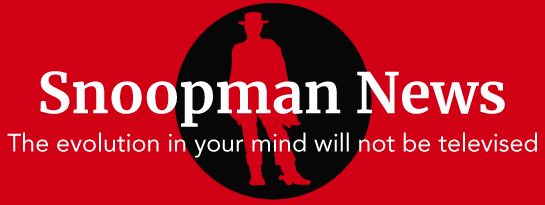The New Zealand Crown oversees a Neo-Colonial jurisdiction whose public and private institutions manage a Shock Doctrine economic warfare framework for the benefit of Rich-Listers, foreign and domestic, to the detriment of New Zealand society. A ‘re-set’ of New Zealand onto a Neo-Colonial State trajectory occurred at a quickened pace in mid-1984 with the capture of the Lange-Labour Government. This capture of the public state was orchestrated for the purposes of facilitating a hostile corporate takeover of the New Zealand economy, so it could be transformed into a Switzerland of the South Pacific Utopia.[1]
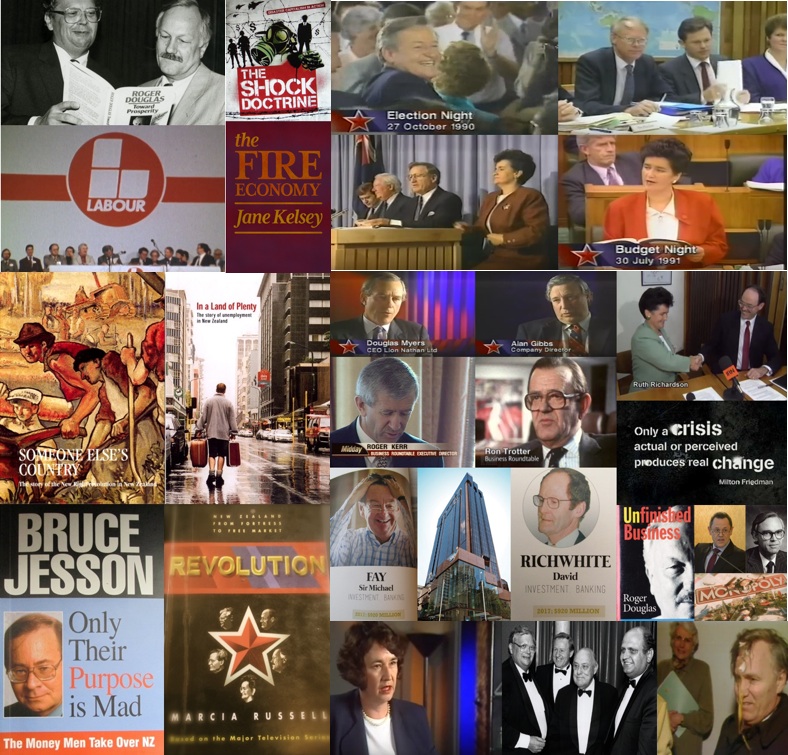
By Snoopman, 18 November 2018
Global Shock Doctrine Reset
The implementation of a Shock Doctrine economic warfare framework includes a 34 year-old hidden state policy of structural unemployment,[2] a rapid transfer of the New Zealand Tax Herd-funded state assets into private consortiums,[3] and a deepened incursion into households of the debt based monetary and credit manufacturing system that was formalized during the Masonic New Zealand Wars.[4] ‘Free market’ economic shock therapies – which included mass lay-offs in the public and private sectors, deep cuts to public services in the provinces and individualized employments contracts – were implemented with callous rapidity. The shock treatments were, therefore, mechanisms of coercion, because all sectors of society were thrown into crisis through strategic sabotage of industries.
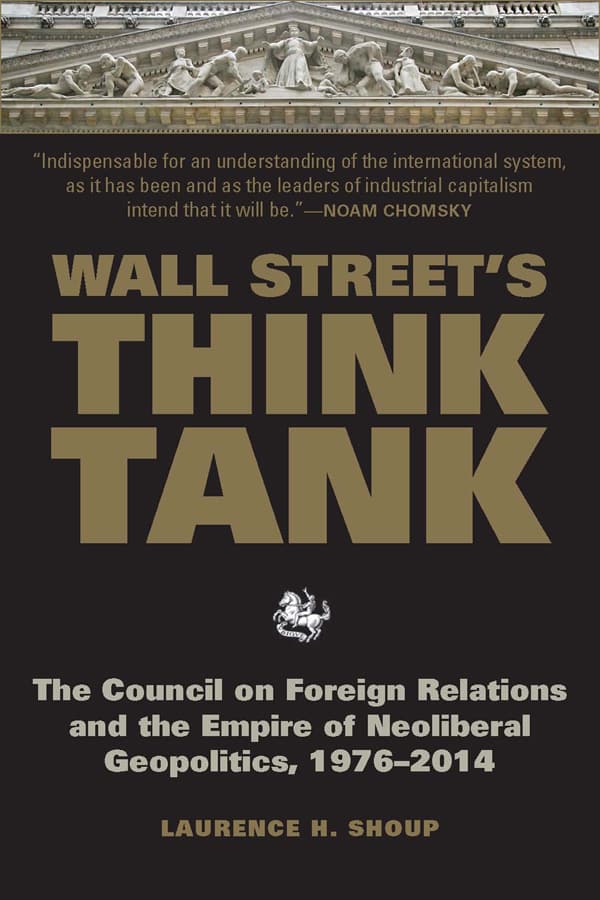
The impetus for this re-set of the New Zealand Realm and the rest of the world came from the then-North Atlantic Capitalist Class, who faced several major crises in the mid-to-late 1960s. These calamities were a structural crisis of Declining Profit Rates for transnational and state-located corporations, a Crisis of Democracy presented by the numerous 1960s Peoples’ Movements and demands from a Developmentalist Movement in the ‘Third’ and ‘Second World’ countries for Western technologies in fair return for the resources supplied to rebuild Western Europe and Japan following WWII. The North Atlantic banking dynasties that owned the Federal Reserve needed to reinvigorate the FED dollar that was backed by the U.S. military.
To counter these crises, the North Atlantic Capitalist Class developed a ‘free market’ economic warfare framework to transform the world, as the documentary Requiem for an American Dream shows.[5] This ‘imperial brain trust’ blueprint – dubbed the ‘1980s Project’ – was first formulated between 1971-1973 at a New York-based global policy-shaping think-tank, the Council on Foreign Relations, as Laurence Shoup and William Minter revealed in their 1977 book, Imperial Brain Trust: The Council on Foreign Relations and United States Foreign Policy.[6]
Key insiders at the Council on Foreign Relations planned the spread of ‘free markets’ by exploiting Chicago University professor Milton Friedman’s modus operandi of ‘speed, suddenness and scope’. These economic shock therapies were field-tested on countries such as: Brazil in 1963, Indonesia in 1965, Chile and Uruguay in 1973 and Argentina 1976 using US-backed military violence to destroy the Developmentalist Movement, as Naomi Klein showed in her 2007 book, The Shock Doctrine.[7] However, the key insiders of what I call a Rockefeller-Kissinger-Bilderberger Nexus knew they needed a scheme layered with subterfuge to gain the submission of governments worldwide, because brutal CIA-backed assassinations, coup d’états and military juntas everywhere would blow their cover.
To this end, a May 1973 secretive Bilderberg Foundation meeting on the island resort of Saltsjöbaden, owned by the Swedish Wallenberg banking dynasty, discussed the impacts of ramifications to oil price shocks in the pipeline.
The 84 Bilderberg Foundation participants included:
Lord Greenhill, chairman of British Petroleum; Sir Eric Roll, of S.G. Warburg Bank; Giovanni Agnelli of Fiat, Italy; Henry Kissinger, US National Security Advisor; Zbigniew Brzezinski, who later co-founded the Trilateral Commission with Bilderberg stalwart David Rockefeller; Marcus Wallenberg, banker of Sweden; banker Baron Edmond de Rothschild of France and Bilderberg Chairman, Prince Bernhard of the Netherlands.[8]
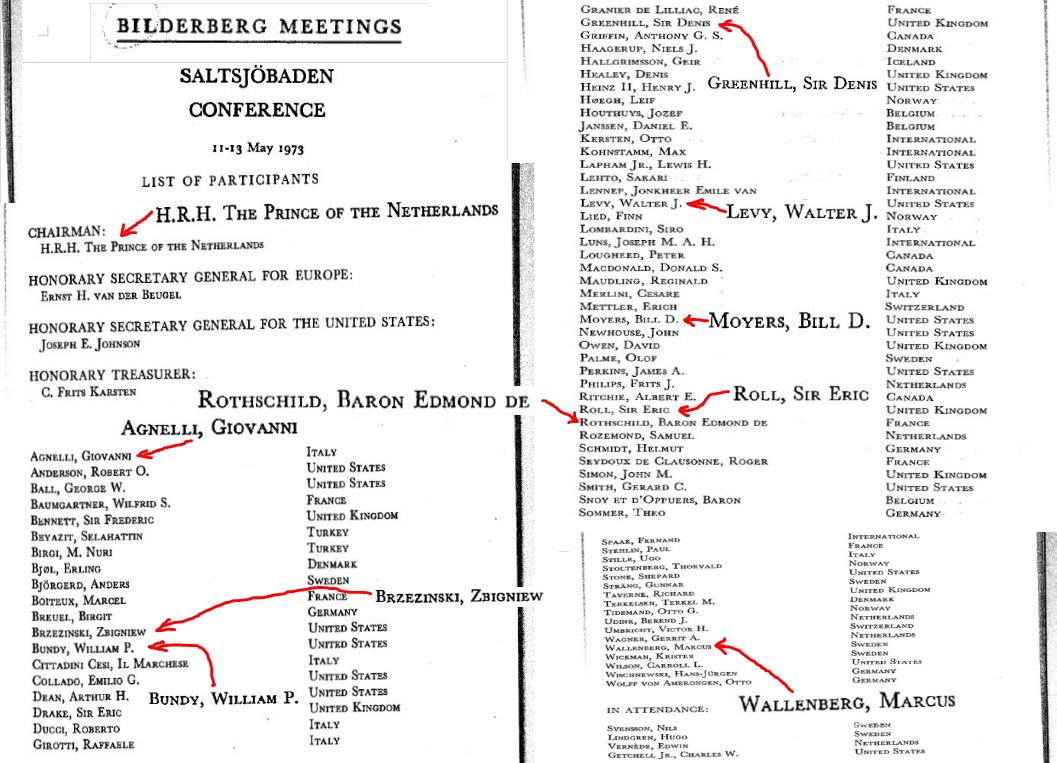
Walter Levy, who was a New York-based oil consultant and who during World War II headed the petroleum section of the Office of Strategic Services, forerunner of the CIA, delivered a paper on oil.[9] Levy presented a scenario wherein the world faced serious challenges to managing the world’s energy consumption, capacity for supply and control of resources, particularly as they related to the potential to “undermine the world monetary system.” Another participant, James Akins, who was a White House and State Department energy expert, estimated that future energy prices would be in the range of FED$10-$12.50 a barrel.[10] In September 1973 oil was FED$2.59 and jumped to FED$11.56 per barrel in January 1974.[11]

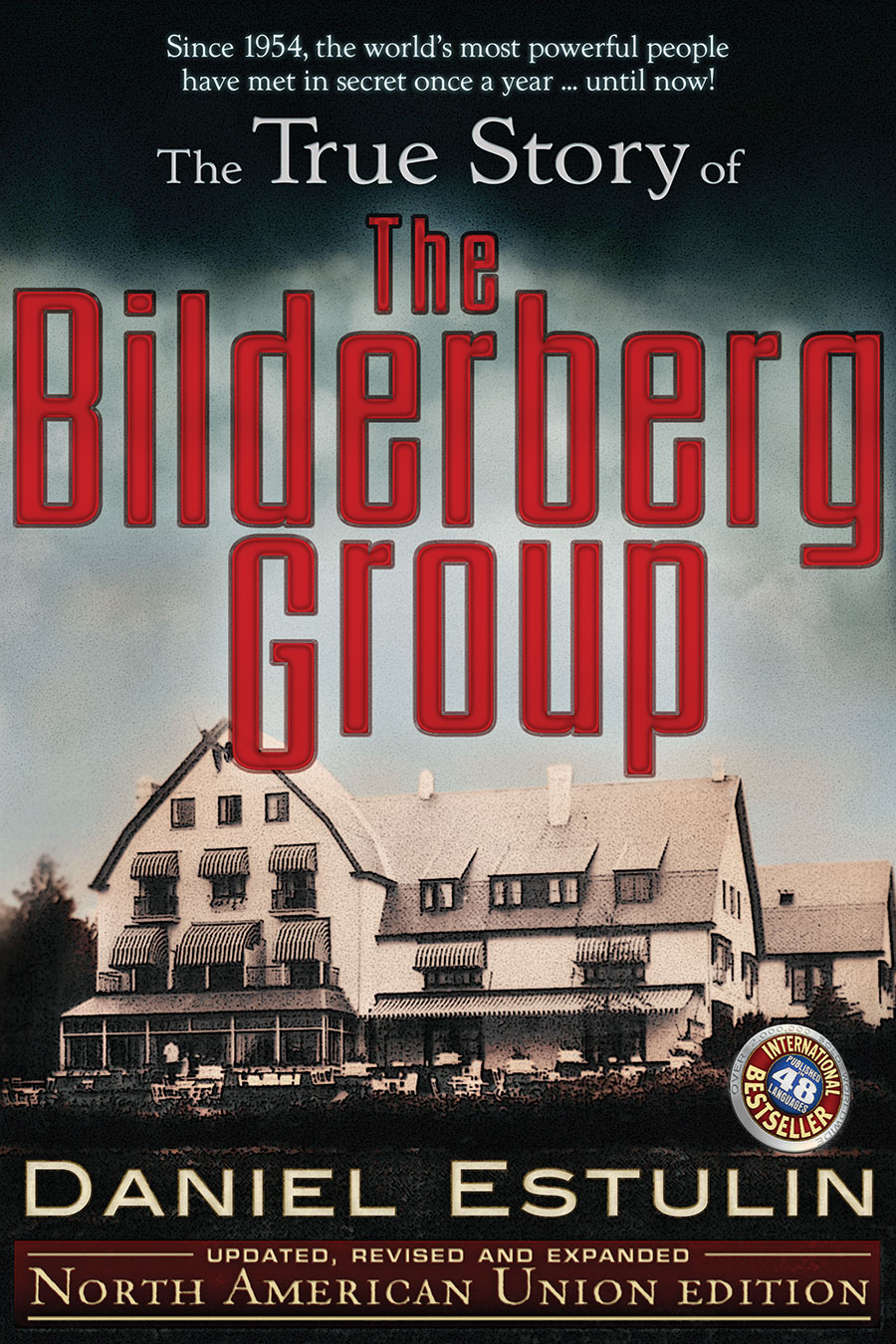
The ‘Dark Prince’ – Henry Kissinger – hatched the idea of supplying U.S. manufactured arms to ‘client states’ to serve America’s imperial aims, and thereby reinvigorate the Federal Reserve’s embattled dollar. In a May 1972 meeting in Tehran, Mohammad Reza Pahlavi – better known as the Shah of Iran – was induced to buy American Made™ weaponry by President Nixon and Henry Kissinger. But the Shah of Iran lacked the cash.
The Rockefeller-Kissinger-Bilderberger nexus worked out that they needed a trigger event that would work as a cover for the Shah of Iran to hike oil prices so that he could afford his military spending. Kissinger, with the assistance of ‘back channels’ in London, orchestrated the Yom Kippur War of October 1973 by deceiving the Egyptians, Syrians and Israeli’s about one others’ agendas. The House of Saud’s King Faisal had already expressed his displeasure to Kissinger and other U.S. officials about U.S. armaments supplies to Israel, and warned of an OPEC oil embargo.[12] U.S. intelligence confirmed a build-up to war was underway, and with the Dark Prince playing Ares, the Greek mythical God of War, Egypt and Syria were manipulated into invading Israel on October 6 1973.
Key insiders from Washington, New York and London had correctly calculated that Arab oil-producing countries would react to U.S. support of Israel in the war by imposing an oil embargo on the United States. The ensuing oil embargoes on the US and the Netherlands (since Rotterdam was a major oil port for western Europe) and the resultant increases in oil prices, meant that the much of the world was forced to pay 400% more for petroleum, which was traded in U.S. dollars, amid the apparent oil scarcity. Conspicuously, the Shah of Iran ‘boycotted the boycott’ and increased oil output to the U.S. and British ports to counter the ‘scarcity’.
In turn, this meant that Wall Street banks and most especially Rockefeller’s Chase Manhattan Bank, made enormous profits from ‘Petro-Dollars’. Chase Manhattan Bank was the Iranian government’s bank, as well as the bank of the National Iranian Oil Company and the Shah’s family bank, and the Pahlavi Foundation’s bank.
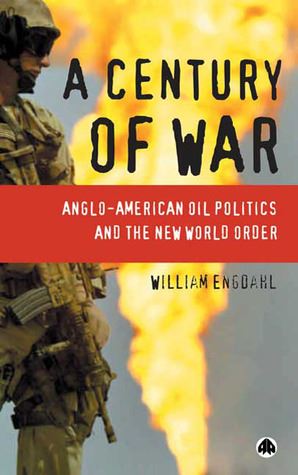
Amid rapidly rising oil prices in 1973-74, an inflationary period ensued around the world. In his book, A Century of War: Anglo-American Oil Politics and the New World Order, William Engdahl, stated the inflationary spiral caused by the Bilderberger Nexus Oil Price Shocks of 1973-1974 resulted in the cost of energy and transportation cumulatively rose by 1300% in the six years to the end of 1979.[13] Engdahl, who found a copy of the 1973 Saltsjöbaden Bilderberg Meeting Report in a Paris bookshop, argued that the 1970s ‘energy crisis’ served as a pretext for the Wall Street-Washington-City of London Complex to increase the cost of credit to 20% (amid runaway inflation). Fed Chairman Paul Volcker achieved this 20% hike for Federal Reserve’s credit through restricting the currency supply, ostensibly to control inflation, as the documentary Money for Nothing: Inside the Federal Reserve, showed.[14]
Meanwhile, exports plummeted as families’, businesses’, governments’ purchasing power dropped, production costs for all countries soared, and states ‘borrowed’ from the central banks’ central bank, the IMF, because tax revenues fell as exporters’ sales sunk and whole economies stagnated. When combined with the underlying Bilderberg Nexus-induced economic crisis, a world debt crisis emerged as interest costs on IMF emergency ‘loans’ soared in this epic strategic sabotage of industry. This is how and why an epic debt bubble blew into the ‘World Debt Crisis’ of 1982.
In keeping with the anti-competitive behaviour of cartels, Henry Kissinger explained that the U.S. was seeking to “create a world price for oil”, according to former U.S. Air Force Colonel L. Fletcher Prouty who heard Kissinger say this at one session of a U.S. Federal Staff Energy Seminar (which evidently ran for four years).[15] This four-year long ‘Energy Seminar’ followed a Ford Foundation-sponsored three-year study, the Energy Policy Project, begun in December 1971 by McGeorge Bundy, who was a mentor of Kissinger at Harvard University.
Thus, the ‘deep state’ oil price shocks laid the groundwork for further ‘free market economic shock therapies’, which were themselves mechanisms of coercion, because all governments and sectors of society were thrown further into crisis. Everyone suffered, except key insiders, who became richer and accumulated more power – economically, politically and militarily.
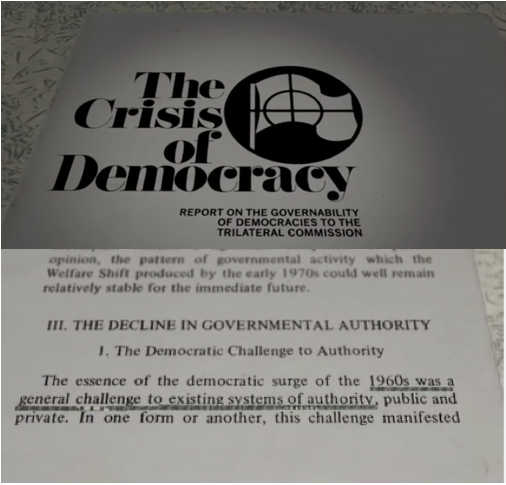
In this way, key deep state players – who belonged the global policy-shaping think-tanks such as the Bilderberg Group, the Council on Foreign Relations and the Mont Pèlerin Society[16] – were able to inflict Shock Doctrine economic warfare globally. Another think-tank, the Trilateral Commission, was established in 1973 and tasked to formulate policies, strategies and tactics to deal with what was termed a Governance Crisis. The Elite planners resolved to encourage political apathy, as this ‘governance crisis’ literature of this period makes evident.[17] From their perspective, there was a ‘Crisis of Democracy’ because there was too much participation from ‘below’.[18]
In their loyal work for the Anglo-Swiss-American Oligarchies, the North Atlantic Capitalist Class advanced what the Bilderberg Group-mouthpiece, The Economist magazine,[19] called the “counterrevolution”. This epic political conspiracy was a manifestation of spectacular power, since the regime changes that occurred through US-NATO military violence not only facilitated rapid resource accumulation for the Western coalitions of oligarchs. The US-NATO military empire’s regime changes that were inflicted on countries outside the Western Neo-Capitalist Bloc worked as mechanisms of coercion on governments within its own orbit, as Klein’s book The Shock Doctrine and Engdahl’s A Century of War demonstrate.
Work-shopping the ‘1980s Project’
For the rest of the 1970s — and in coordination with their British counterparts — global policy-planners in Gotham City wrote scholarly papers, held seminars and work-shopped their ‘1980s Project’ to re-assert the dominance of the then-North Atlantic Capitalist Class. The Council on Foreign Relations members, and their counterparts, intended to re-invigorate the United States of America’s dominance over the world by exploiting speed – a necessary component used to capture control of political spaces through the collapse of time. Their modus operandi was to engineer sudden fast-moving events broad in scope to overtake the deliberative processes of the public state, overwhelm citizenries in their efforts to mobilize counter-forces and coerce the capitulation of public and private sector institutions.
When Britain ceased being a colonial power after WWII, the privately owned municipal City of London Corporation adapted to become a financial power by creating a web of secrecy jurisdictions where wealth could be hidden in offshore islands, as the documentary, The Spider’s Web: Britain’s Second Empire shows.[20] Via this Neo-Colonial system, wealth was captured from across the globe, so that control over former colonial jurisdictions could be regained and retained by stealth, and beyond public state scrutiny.
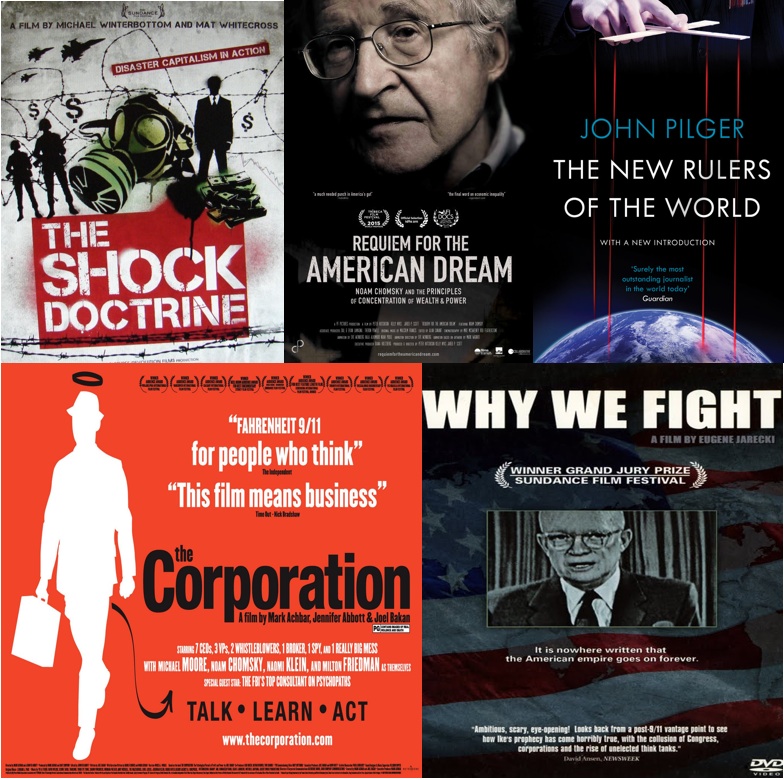
Indeed, once a country is captured by Neo-Colonialists, a dynamic is set in motion that compels neighbouring countries to adopt the Neo-Colonial framework to construct a New World Order Utopia with techno-feudal police super-states. Such emergent super-states are characterized by a displacement of democratic administrative systems with technocracy, which is a totalitarian form of government managed by technicians, engineers and scientists brainwashed to believe they are building unbiased governance infrastructure, when in fact technocracy transforms imperfect mechanisms for social control into a formidable scientific dictatorship for the benefit of unseen, super-rich oligarchies.
In the West, the US-NATO military empire enforces regime changes to feed the excessive capital accumulation ‘needs’ of super-rich neo-feudal capitalist coalitions, in keeping with the diabolical philosophy of oligarchism – which is the pursuit of extreme wealth through huge wealth transfers, a cruel system that produces mass poverty, dislocation and submission and in its most virulent form manifests as world domination utopian strategies.[21]
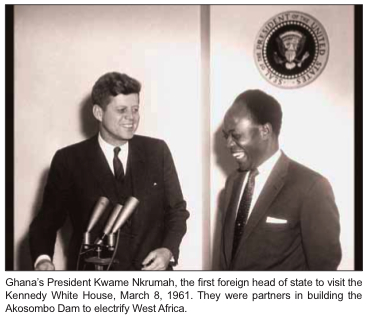
New Zealand appears to have political independence but is, in fact, one of world’s 193 countries that have been absorbed, to varying degrees, into this stealthy Global Neo-Colonial paradigm. As the former President of Ghana, Kwame Nkrumah found while making a PhD study of African countries that had won nominal independence, Africa’s resources, banks and financial systems of Africa were still controlled by a vast monopolistic network of North American and European dynastic families, corporations and their inter-linked representatives.
Nkrumah wrote in his 1965 book, Neo-Colonialism: The Last Stage of Imperialism, that though a Neo-Colonial state had the outward appearance of international sovereignty, the political apparatus took external directions because its economic resources and financial systems were controlled from the outside. Nkrumah’s findings some 59 years ago shine valuable light on the impetus for the re-set of world in the 1980s – including New Zealand in 1984 – with the deployment of the ‘free market’ economic shock treatments, that was eventually named as the ideological construct – Neo-Liberalism.
Rather ironically, the ongoing economic warfare that was designed into CFR’s ‘1980s Project’ blueprint is rendered invisible by the discourses on Neo-Liberalism because such critics also often fail to locate Neo-Liberal policies as Shock Doctrine economic warfare frameworks. By overlooking, avoiding or downplaying the reset of the world economy that occurred with the deployment of the ‘1980s Project’ – and after field-testing the Shock Doctrine economic warfare in the 1960s and 1970s – Neo-Liberal discourses miss the bulls-eye. Such discourses fail to realize that the market development of an ideological construct that is designed to: reassert the economic, political, military and cultural dominance of the then-North Atlantic Capitalist Class; to suppress pressures for ‘too much democracy’; and to permanently resist its dismantlement – means that a well-resourced political conspiracy occurred.
This comprehension failure of the inherent conniving callousness to the ‘Neo-Liberal Project’ derives from a widespread belief that such phenomena occurs only through spontaneous, uncoordinated reactions to structural forces such as those mentioned earlier, that occurred in the mid-to-late 1960s – including the structural crisis of Declining Profit Rates for transnational corporations, the Crisis of Democracy presented by the 1960s Peoples’ Movements, and the Developmentalist Movement of Second and Third World countries whom demanded Western technologies as fair exchange for the harvesting of their resources. Yet, resets to maintain power over economic, political, military and cultural resources require political conspiracies, or the activation of instrumentalist forces.
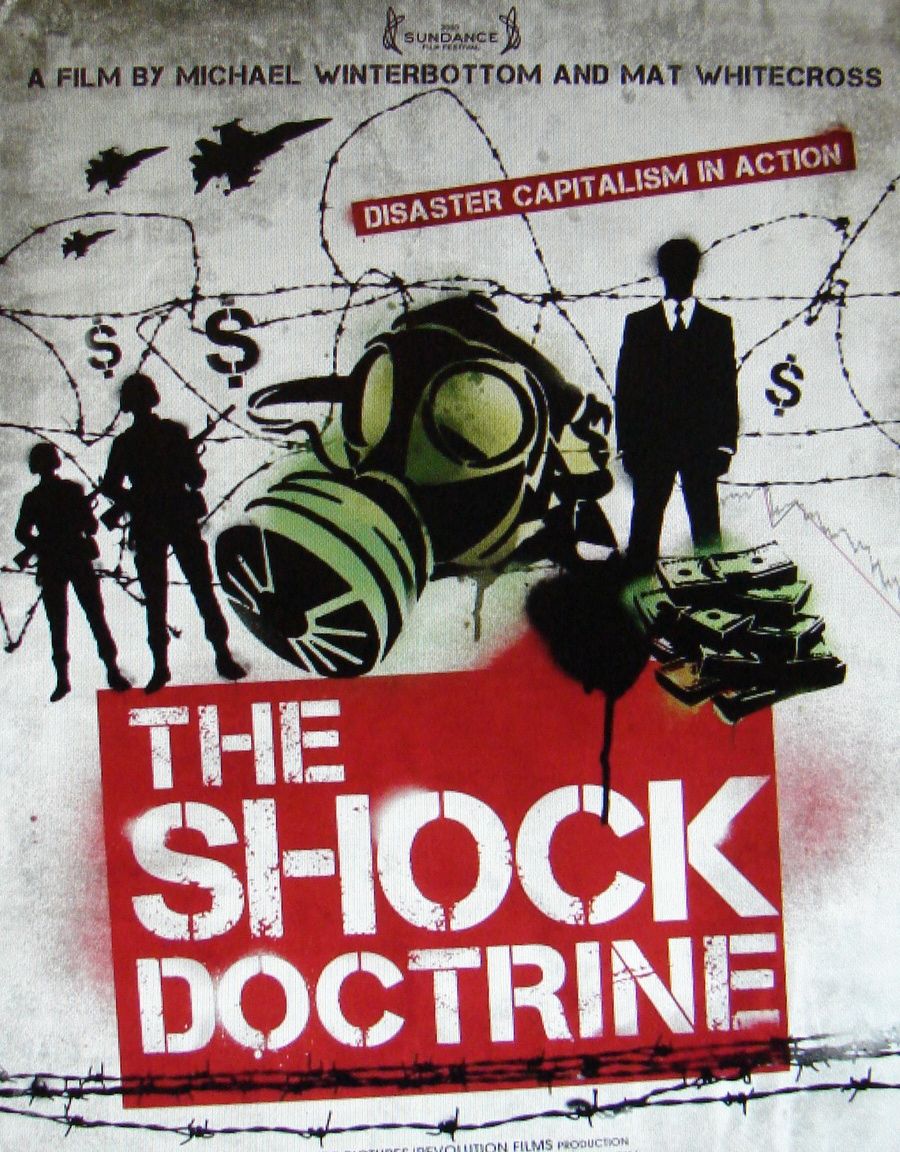
The ideological construct, ‘Neo-Liberalism’, was never named as such. The reforms were, however, called ‘free market’ which matched the rhetoric that there would be ‘less government’ because commerce was going to be ‘de-regulated’, when in fact it was, and continues to be, re-regulated. The exponents of ‘free markets’ did not talk about the networks of think-tanks that proliferated with capitalist class funding because that would have drawn attention to who was behind the genesis, incubation, and transplanting of ‘free market’ ideas.
It would also have risked hinting that there were instrumentalist Deep State resets occurring simultaneously, since naming a well-resourced network of elites would have revealed linkages to dominant coalitions of capitalists, or oligarchies, at a time when big world-shaping events were current in mass memory.
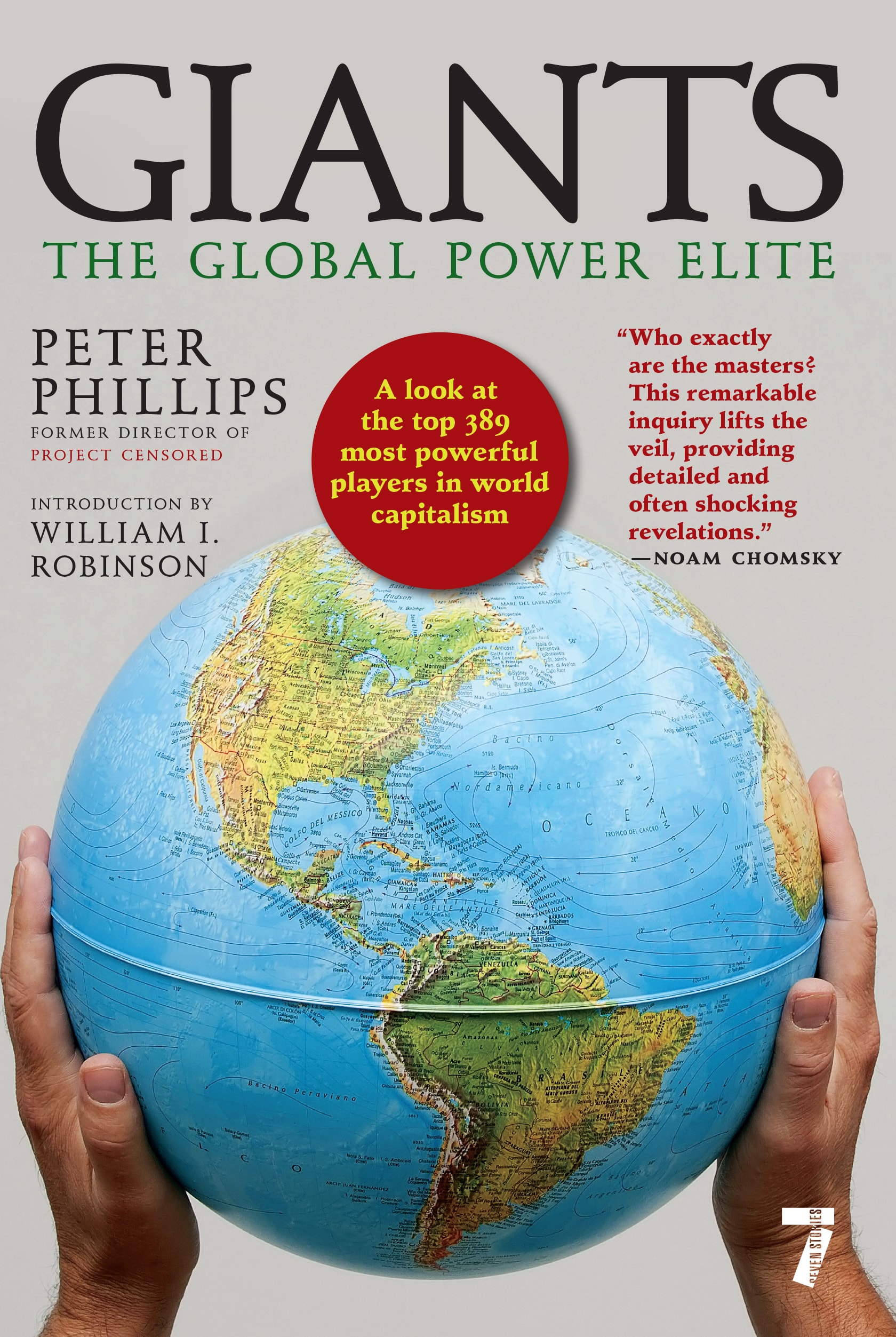
The unveiling of such networks would have ruined the theatre of news, which is episodic by construct, and contextualizes such machinations as simply the results of a chaotic world undergoing organic or unpredictable political crises requiring pragmatic solutions resolved upon in circumstances deemed too complex to pinpoint a root-cause. This cacophony of crises renders the culprits as invisible as the ideologically-infused economic warfare frameworks under deployment. Therefore, Neo-Liberalism is more like a Formica finish that hides the shitty custom-wood materials of the cabinetry: Neo-Colonialism.
The deployment of the Shock Doctrine economic warfare framework in New Zealand was driven from overseas, through a network of think-tanks. These included the Mont Pèlerin Society, the New Zealand Business Round-Table and the Tasman Institute.
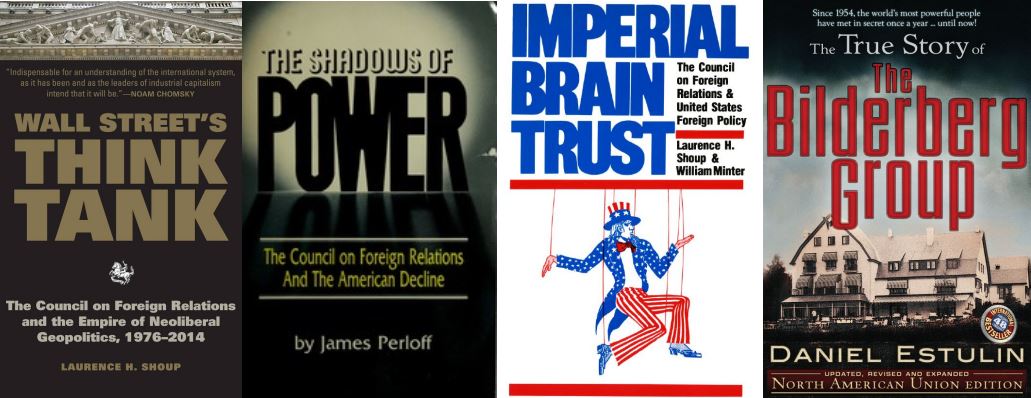
‘Switzerland of the South Pacific’ Utopia
In the mid-1980s, merchant bankers Michael Fay and David Richwhite shared with investors their utopian vision for New Zealand: a ‘Switzerland of the South Pacific’.[22] In late 1986, the pair floated a company called European Pacific Banking Corporation that was based in the wealth secrecy haven of Luxembourg.[23] The trajectory they set to transform New Zealand into a financial secrecy haven favourable for undead banking consortia is still alive.
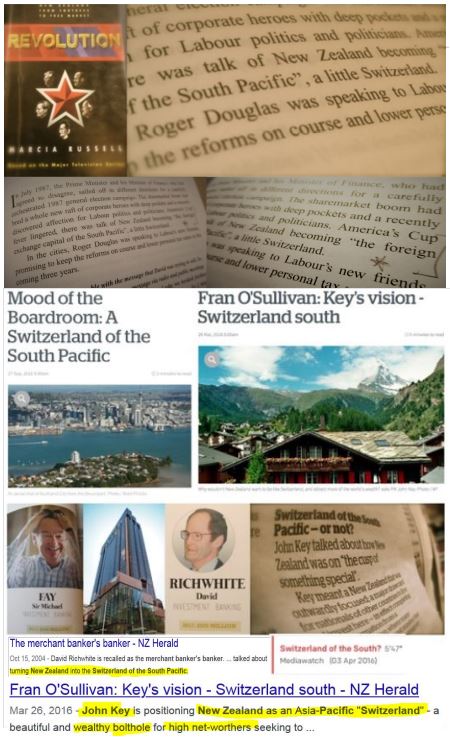
This economic warfare reset to make New Zealand into a ‘Switzerland of the South Pacific’ Utopia for centimillionaires, billionaires and transnational corporations is shown to have been part of a broader reset called the ‘1980’s Project’, which was a blueprint to transform the world with Neo-Colonial ‘market economies’ designed at the New York-based think tank, the Council on Foreign Relations, that was chaired by Chase Manhattan bank chairman, David Rockefeller, from 1970 to 1985.
In the process, the New Zealand economy, its companies and its strategic resources became more tightly teethered to the ‘Trilateral World’ of North America, Western Europe and Japan.
The un-mandated moves to make Greater Auckland into a huge city were an expression of a broader ‘World Cities Movement’ Project that has forged Global Cities. The purpose of forging Global Cities is to support the huge geographically dispersed transnational corporations that require jurisdictions to facilitate high capital mobility, organize public debt-funded infrastructure, and accommodate large pools of excess labour. The endgame is high-tech Neo-Colonial technocratic jurisdictions owned by the wealthy, regionalized Police super-states and a chipped world where privacy, indigeneity, and love is extinct.
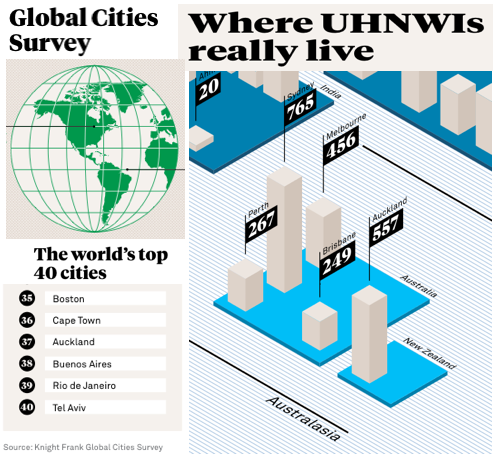
To this end, the Neo-Colonial institutions and individuals behind the corporate siege of New Zealand rammed through policies, processes and protocols to create structural growth pressures so that Auckland City would eventually attain Global City status.
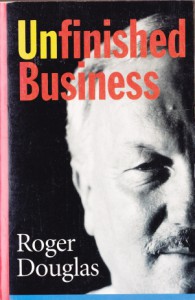
Brazenly, Lange Labour Government Finance Minister Roger Douglas, who was falsely credited with being the ‘architect’ of the economic shock therapies, bragged in a private dinner conversation in December 1986 that the idea behind the ‘free market’ reforms was to transform New Zealand into a Switzerland of the South Pacific. Douglas said a top strata of super-wealthy would rule and in 25 years time, most New Zealanders – including indigenous Māori – would not be able to afford to live in N.Z.[24]
To that end, the diabolical philosophy of oligarchism was adopted as unofficial corporate-state policy – which is the pursuit of extreme wealth through huge wealth transfers, a cruel system that produces mass poverty, dislocation and submission. Coalitions of super-rich people re-grouped as a Neo-Colonial oligarchy, to use their enormous wealth to steer the political trajectory during this reset of New Zealand.
Because oligarchs can only exist in societies with extreme economic equality, and because they thrive in crisis-ridden societies, and because their diabolical philosophy of oligarchism became corporate-state policy, New Zealand’s Rich-Lister oligarchy and their colluding foreign counterparts, are the root cause of the poverty crisis, along with the other crises, such as the housing affordability, homelessness and debt crises that beset the country.
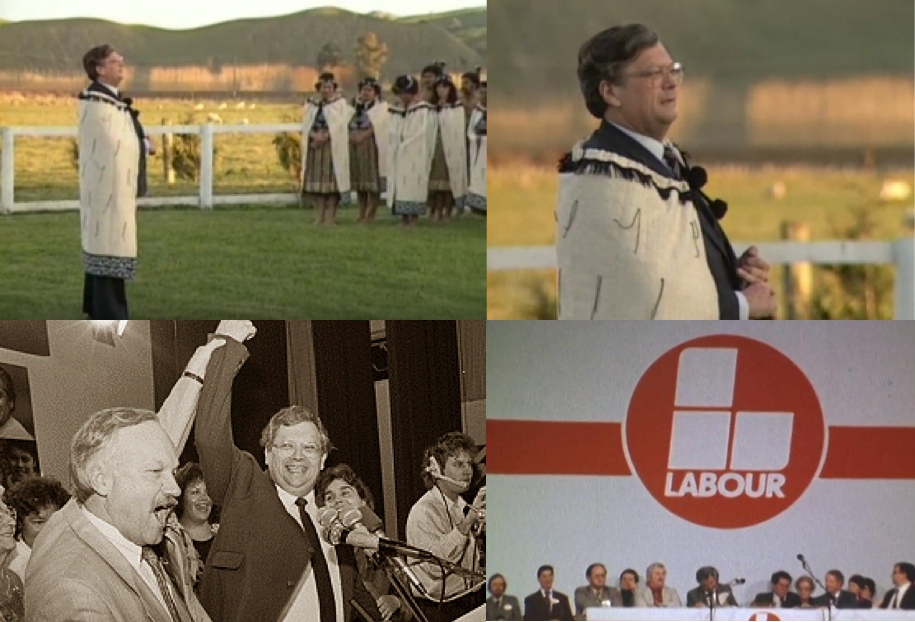
By 2015, Auckland became ranked as a ‘Global City’ in 37th place in a Top 40 Global Cities Survey that cast the city as a safe-haven for 557 Ultra High Net-Worth Individuals with investible wealth of $30 million or more, as published in Frank Knight Capital Management’s Wealth Report. (This initiative got a series in The Herald, while land buybacks for Māori in 2019 did not).[25]
The result is that New Zealand gained the crisis-indicating ranking of being the most unaffordable place to live in the world – as London-based Bilderberger Group mouth-piece, The Economist magazine, reported in March 2017.[26] Indeed, the bottom 1% or 42,000, were so poor they were classified as homeless,[27] while the top 10 percentile of the 1% were so rich, the National Business Review reported their wealth to be $55.84 billion[28].
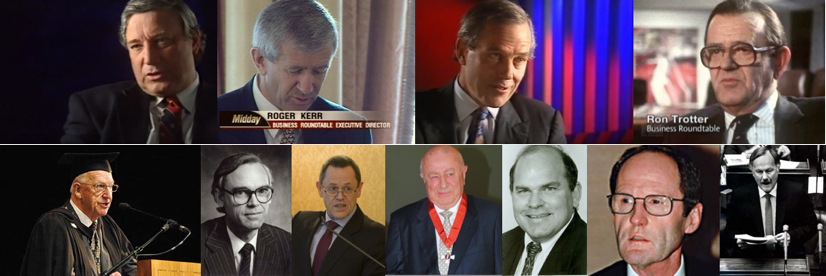
The Crown’s complicity in maintaining the 35 year-old economic warfare paradigm that key members of the New Zealand Labour Party engineered, such as Roger Douglas, David Caygill and Richard Prebble, with such corporate luminaries as Fletcher Challenge, its Chairman Ron Trotter, and other members of the NZ Business Round-Table, including former Crown officials, such as Roger Kerr, Roderick Deane, and Bryce Wilkinson – means that the Crown’s public stance about finding solutions to child poverty, homelessness and the housing crisis is theatre to control the crisis rituals.
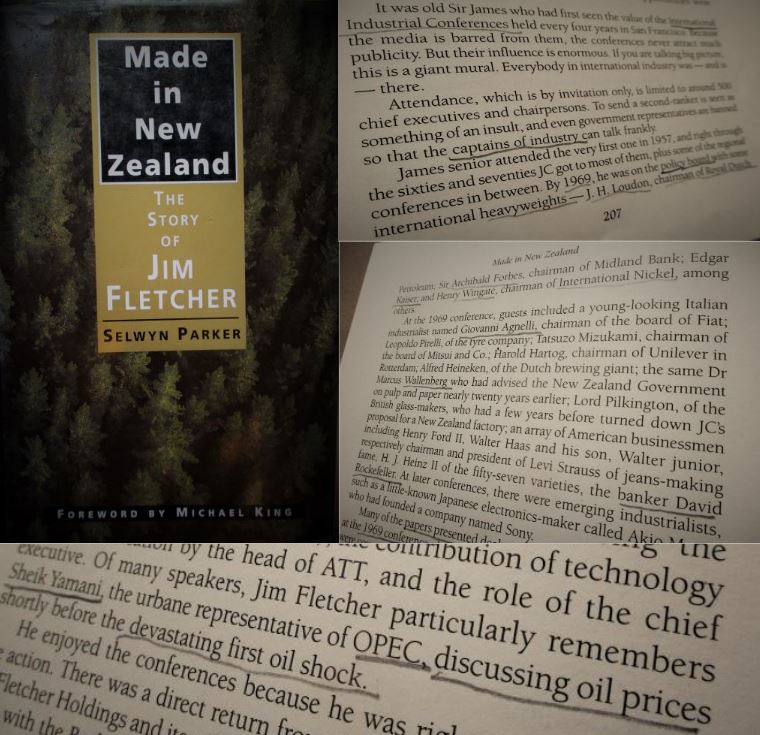
To sum up, successive New Zealand Government’s since the Lange-Labour Government have been recklessly complicit in protecting the racketeering interests of cartelized commerce. That cartelized commerce got a high octane boost with the 1973-74 Oil Price Shock orchestrated by the ‘Rockefeller-Kissinger-Bilderberger Nexus’. This 1973-74 Oil Crisis not only meant that Wall Street banks, and most especially Rockefeller’s racketeering Chase Manhattan Bank, made enormous profits from ‘Petro-Dollars’. It also reinvigorated the US currency of the US FED dollar, which is owned by the Federal Reserve cartel and worked as an economic warfare mechanism to weaken governments, industries and households to submit to the sieges being planned concurrently by such think-tanks as the Council on Foreign Relations, the Trilateral Commission and the Bilderberg Group.
In short, the ‘Globalization Reset’ was triggered by the Yom Kippur of October 1973 to engineer the 1973-74 Oil Price Shocks, that were designed to reinvigorate the global hegemonic order of the US FED dollar, since this engineered crisis would work as the levers to reset the structural forces onto the desired trajectory.
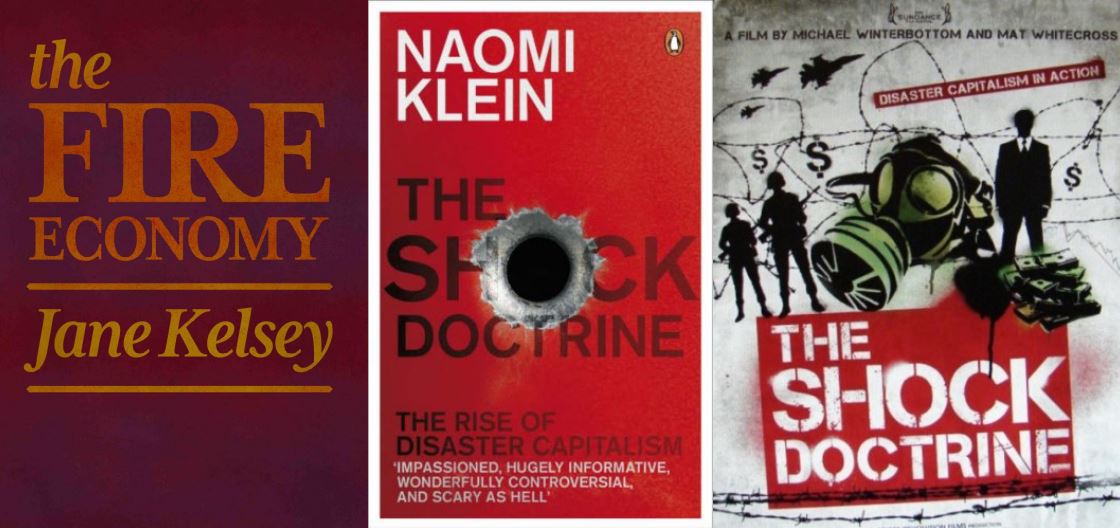
The regulatory capture of the New Zealand Government by a Neo-Colonial Confederacy that occurred in 1984 persists today. This persistence of inflicting economic warfare upon New Zealanders requires mutinies within and across institutions. The identified root causes of New Zealand as a crisis-ridden society point to bona-fide solutions. These include: dismantling the international bankers’ racketeering debt-based money system and its replacement with positive money including cash and public credit, savings pools and time-dollar systems to resource communities with needed projects.
The protection of the nations’ wealth lays with a dynamism in invention, innovative enterprises, and a healthy mix of competition, cooperation and courageousness community to dismantle the cartelization of industry, stealthy tax havenry and the Old Boys’ Network cronyism. New Zealand also needs to facilitate indigenous-led land reform to establish self-determining communities, as a counter to resource-grabbing transnational cartels, particularly since it was Māori who acted as a bulwark against the corporate takeover of New Zealand, by taking the Crown to the High Courts to prevent or slow down state asset sales.
—– |—–
See also: Discretionary Idleness: Structural Unemployment as an Economic Warfare Tool in Neo-Colonial New Zealand at: https://snoopman.net.nz/2018/11/19/structural-unemployment-as-an-economic-warfare-tool-in-neo-colonial-new-zealand/
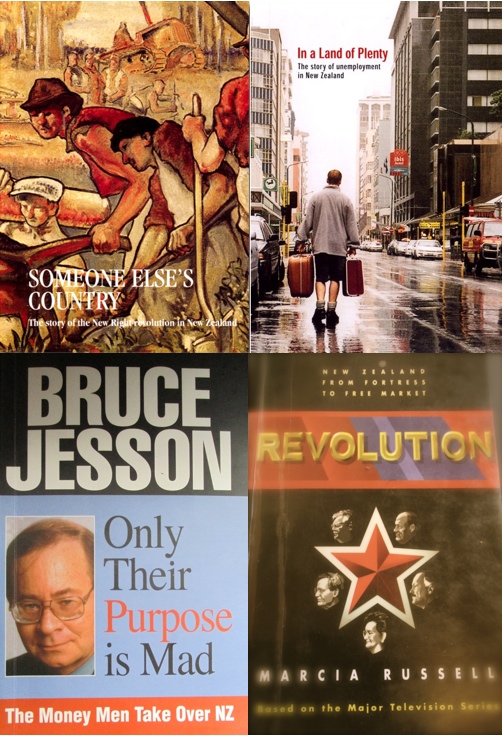
Bankers Take Back-Door Route to Screw NZ Beneficiaries: Indexing Welfare to Wages to Unemployment to the OCR?
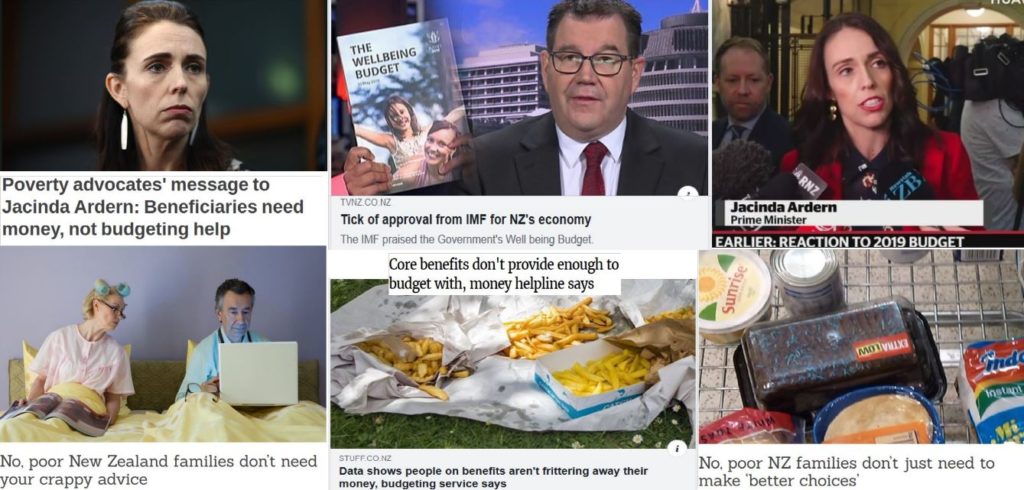
Source References:
[1] Marcia Russell. (1996). Revolution: New Zealand from Fortress to Free Market, p. 141. Mairangi Bay; New Zealand: Hodder Moa Beckett.
[2] Barry, Alister. (2002). In a Land of Plenty: The Story of Unemployment in New Zealand. [Motion Picture]. Vanguard Films. Retrieved from http://www.nzonscreen.com/title/in-a-land-of-plenty-2002
[3] Barry, Alister. (1995). Someone Else’s Country: The Story of the New Right Revolution in New Zealand [Motion Picture]. Vanguard Films. Retrieved from http://www.nzonscreen.com/title/someone-elses-country-1996
[4] Steve ‘Snoopman’ Edwards. (25 April 2017). “The Masonic New Zealand Wars: Freemasonry as a Secret Mechanism of Imperial Conquest During the ‘Native Troubles’ ”. Snoopman News. Retrieved from: https://snoopman.net.nz/2017/04/25/the-masonic-new-zealand-wars/
[5] Peter D. Hutchison and Kelly Nyks. (2015). Requiem for the American Dream: Noam Chomsky and the Principles of Concentration of Wealth & Power. Retrieved from https://www.youtube.com/watch?v=j9asVtLFxpU
[6] Laurence H. Shoup. (2015). Wall Street’s Think Tank: The Council on Foreign Relation Relations and the Empire of Neo-liberal Geopolitics, 1976-2014. New York: Monthly Review Press; Shoup, L. H. & Minter, W. (2004 [1977]). Imperial Brain Trust: The Council on Foreign Relations and United States Foreign Policy, 254-284. New York, NY: Authors Choice Press.
[7] Klein, Naomi. (2007). The Shock Doctrine: The Rise of Disaster Capitalism, p.7. Camberwell, Australia: Penguin Books; Whitecross, M & Winterbottom, A. (Directors) & Eaton, A. (Producer). The Shock Doctrine 2009 [Motion picture] Retrieved from https://www.youtube.com/watch?v=v6yceBTf_Vs;
[8] Engdahl, W. (2004). A Century of War: Anglo-American Oil Politics and the New World Order (Rev. ed.), p. 132, 134, 286-87; Engdahl, W. (2009). Gods of Money: Wall Street and the Death of the American Century, p. 266-267); Public Intelligence. 1973 Bilderberg Meeting Participant List. https://publicintelligence.net/1973-bilderberg-meeting-participant-list/
[9] Public Intelligence. (February 11, 2010). Bilderberg Foundation Saltsjöbaden Conference Report, Sweden,11-13 May 1973, p.22-35. Retrieved from https://publicintelligence.net/1973-bilderberg-meeting-participant-list/
[10] Public Intelligence. (February 11, 2010). Bilderberg Foundation Report 1973, p.63. Retrieved from https://publicintelligence.net/1973-bilderberg-meeting-participant-list/
[11] F. Kesicki. (2009). The third oil price surge – What is different this time and what are possible future oil price developments? Universität Stuttgart Institut für Energiewirtschaft und Rationelle Energieanwendung. Retrieved from https://www.ier.uni-stuttgart.de/publikationen/arbeitsberichte/downloads/Arbeitsbericht_07.pdf
[12] OPEC is a market-monopolizing cartel, Organization of Petroleum Exporting Countries.
[13] Engdahl, W. (2004). A Century of War: Anglo-American Oil Politics and the New World Order (Rev. ed.), p. 127-141. London, England: Pluto Press; Engdahl, F. W. (2009). Gods of Money: Wall Street and the Death of the American Century, p. 265-272. Wiesbaden, Germany: edition.engdahl; Estulin, D. (2009). The True Story of the Bilderberg Group (North American Union ed.), p. 183-184. Walterville, OR: Trine Day LLC.
[14] (2015). Money for Nothing: Inside the Federal Reserve. Liberty Street Films. https://www.youtube.com/watch?v=maC7phpUVno
[15] William Tyndale. (July 31, 2013). The Dirty Truth About Oil. Interview with Col. L. Fletcher Prouty. Retrieved from https://www.youtube.com/watch?v=XXnUD2-joAc
[16] Hutchison and Nyks. (2015). Requiem for the American Dream; Shoup, L. H. & Minter, W. (2004 [1977]). Imperial Brain Trust: The Council on Foreign Relations and United States Foreign Policy, 254-284. New York, NY: Authors Choice Press.
[17] Douglas, J. (1976, October). The Overloaded Crown. British Journal of Political Science, Vol. 6, No. 4, pp. 483-505.Cambridge University Press. Retreived from jstor.org.stable/193284; Rose, R. (1979, September). Ungovernability: Is There Fire Behind the Smoke?” Political Studies. Vol. 27 (3), 351-370; Shoup & Minter (2004 [1977]). Imperial Brain Trust.
[18] de Angelis, M. (2001, May). Global capital, abstract labour, and the fractal panopticon. The Commoner. Retrieved from http://www.commoner.org.uk/fractalpanopt.pdf
[19] Naomi Klein. (2007). The Shock Doctrine, p. 78. Explain governance crisis – too much democracy .. Requiem for the American Dream: Klein, Naomi. (2007). The Shock Doctrine: The Rise of Disaster Capitalism, p. 78. Camberwell, Australia: Penguin Books.
[20] Watch: The Spider’s Web – Britain’s Second Empire Revealed. https://www.zerohedge.com/news/2018-09-22/watch-spiders-web-britains-second-empire-revealed
[21] Patrick Wood. (Dec 1, 2015). Rebuilding Babel: Toward the endgame of Technocracy. Retrieved from https://independencedaily.co.uk/rebuilding-babel-toward-the-endgame-of-technocracy/; Patrick Wood. (2015). Technocracy Rising: The Trojan Horse of Global Transformation. USA: Coherent Publishing; Naomi Wolf. (2007). The End of America; Jason Bermas (2010). Invisible Empire: A New World Order Defined. [Documentary]. USA; Prof. Peter Phillips. (2018). Giants: The Global Power Elite. Penguin.
[22] Marica Russell. Fortress New Zealand p. [XX
[23] Ian Wishart. (1995). The Paradise Conspiracy. Howling at the Moon Publishing.
[24] Confidential source in private conversation with three witnesses.
[25] Knight Frank (2015). The Wealth Report, p28-31. Retrieved from: content.knightfrank.com/research/83/documents/en/wealth-report-2015-2716.pdf; NZ Herald. (14 Aug, 2015). World-Class Auckland: How to improve New Zealand’s largest city. https://www.nzherald.co.nz/world-class-auckland-best-city-on-earth-herald/news/article.cfm?c_id=1503861&objectid=11496080; Is Auckland an entrepreneurial or global city? James E. Rowe The Town Planning Review Vol. 77, No. 5 (2006), pp. 583-604 Published by: Liverpool University Press https://www.jstor.org/stable/41229026
[26] Caley Callahan. (10/03/2017). New Zealand housing most unaffordable in the world – The Economist. http://www.newshub.co.nz/home/money/2017/03/new-zealand-housing-most-unaffordable-in-the-world-the-economist.html; The Economist (Mar 11th 2017).https://www.economist.com/blogs/graphicdetail/2017/03/daily-chart-6; THE DATA TEAM. (Mar 9th 2017). Global house prices. Retrieved from: https://www.economist.com/blogs/graphicdetail/2017/03/daily-chart-6
[27] Rosanna Price. (3 June 2016). One in 100 Kiwis homeless, new study shows numbers quickly rising. http://www.stuff.co.nz/national/80719962/One-in-100-Kiwis-homeless-new-study-shows-numbers-quickly-rising
[28] National Business Review. (2017). NBR Rich List 2017.
